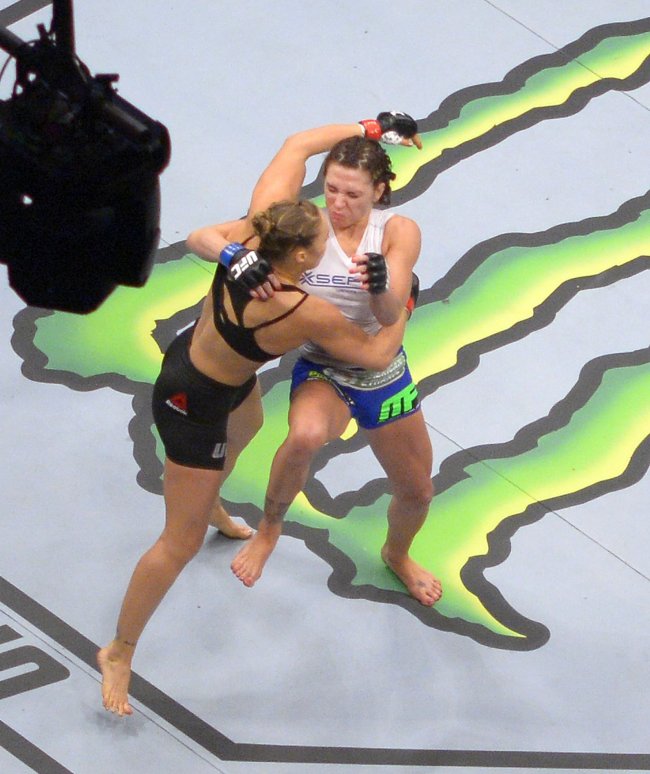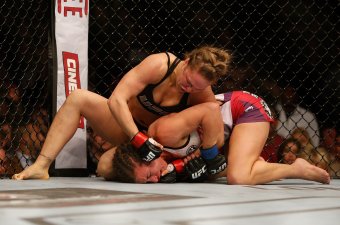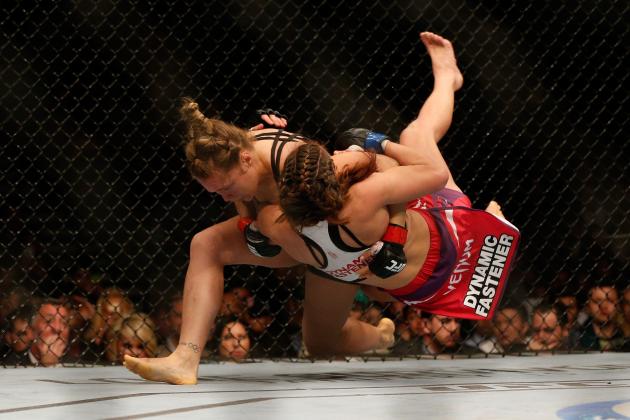For her 12 professional fights, UFC champion Ronda Rousey has needed just 25 minutes and 36 seconds in the cage to finish them. Rowdy has made a name for herself as a fast finisher; it's her calling card.
To try to evaluate her ground game presents a challenge: We've barely seen it. What we have seen is her standing grappling and how her mastery of judo so often leads right to submissions once she gets to the ground.
Even with the limited ground game we've seen from Rousey, there are some tendencies—besides the armbar—that surface regularly. As Chad Dundas writes, unless Holly Holm makes zero mistakes this weekend at UFC 193, Rousey should be able to force Holm to play her game. While Holm is a powerful striker, it doesn't seem likely she could knock Rousey out with a single strike—and Rousey doesn't need much of an opening to close the distance and clinch up.
So when Rousey faces Holm this Saturday at UFC 193, here's what to look for, should Rousey decide to take the fight to the ground.

While this doesn't take place on the ground, head and arm grabs from standing are an integral part of Rousey's ground game, as it sets up throws. Rousey has utilized this in many of her fights, including the infamous 16-second fight with Alexis Davis at UFC 175, which didn't require ground grappling to finish.
One way she achieves this control is by countering rights by throwing lefts inside, which both softens or blocks the incoming blow and gets her arm between her opponent's shoulder and head. So she's almost halfway there already, and when her opponent starts to struggle against the control, it's usually enough of an opening for Rousey to take control of her opponent's far arm.
Maintaining control with body mechanics and pressure, which is essential to grappling, is another element Rousey is especially adept at incorporating into her ground game. Take, for example, the pointers she provides above on her armbar. The typical instruction for armbars is to keep your knees squeezed tightly together, but Rousey does explicitly the opposite. By crossing her feet under her opponent's far shoulder and splaying her knees outward, she is able to keep the head down without allowing any obvious avenues of escape.
Also mentioned in that video is staying tight to her opponent's near shoulder.
Taking away any space, paired with the pressure from her legs that keeps her opponent flat on the mat, means there's nowhere for that shoulder to go. The fighter can't come up to stack, and since she's stuck to the mat, trying to pull her elbow down by turning onto her side is improbable too.
While some grapplers are fine to work from the bottom, like Fabricio Werdum, Rousey's background in Judo seems to have instilled in her an aversion to it.
In her second fight with Miesha Tate, Rousey ends up with Tate in her guard in the first round. After two failed armbar attempts, Tate is caught in an almost-triangle—her other hand is just barely still inside Rousey's legs—and Rousey shows none of the ease and comfort in her attempts to complete it that she does when setting up armbars.

So the failure to finish the triangle seems borne of a lack of intimacy with the move, rather than a means of stalling Tate or setting up something else. Or hey, maybe she was just playing with her food and felt like punching Tate.
The positions she appears most at ease in—and thusly the most dangerous—are top positions.
Many of her throws end up with the opponent in her side control, and as we have seen, she finished Davis and routinely works armbars from there. On top while her opponent is in turtle is another position Rousey seems very comfortable in; while we don't see her spend a lot of time in it, it's usually because she's using it to transition to an armbar, often by flustering her opponent with strikes.
The keystone of Rousey's ground game is, unsurprisingly, rooted in judo—she aims for explosive offensive grappling in short bursts, rather than patiently biding her time in a game of inches. Usually, it's all she needs. This tendency toward brief bursts of offense on the ground has honed her ability to scramble, as we saw in the Zingano fight—she adapts right away and seems to have a total and immediate understanding of the positions she and her opponent are in.
Given her proficiency in throwing, standing up when things aren't going as well on the ground as she'd probably like is a fairly safe bet for Rousey. And she does it several times in the second Tate fight, including from Tate's open guard while Rousey is standing and can't pass.
This serves her well; so far, no one has effectively controlled her on the ground, and from standing, she has no problem clinching up and getting takedowns or throws. We have seen this in almost all of her fights, and for Holm to have a real chance at winning, she'll do well to keep her distance from Rousey's clutches.
Rousey has the ground game of a judoka who's adapted it very well to MMA—which means we barely get to see it. Unless Rousey is interested in beating Holm at her own game, we'll probably see a little more on Saturday.
















